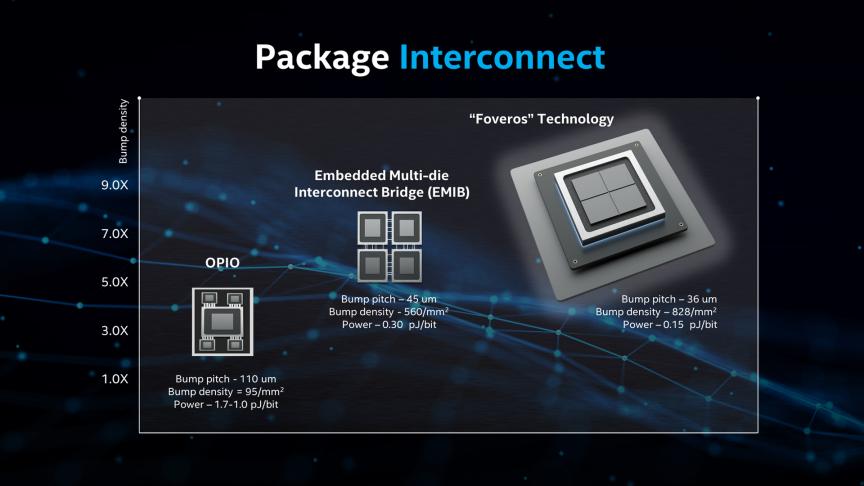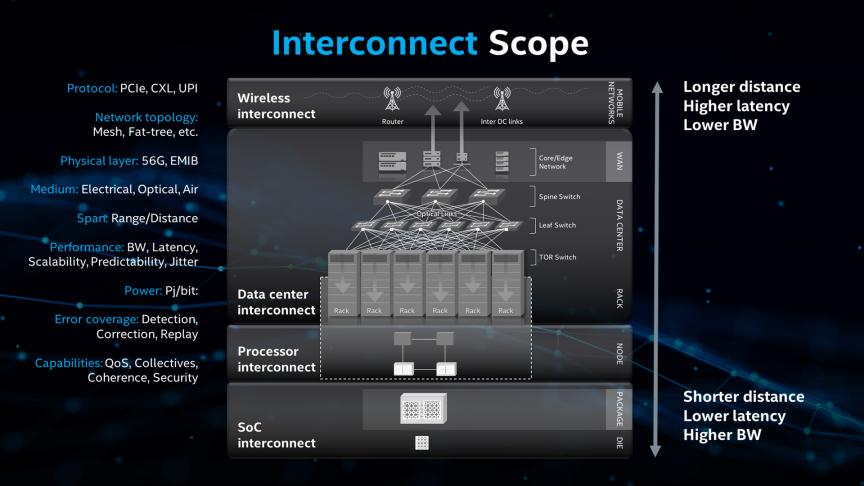Interconnect That Moves Data Faster—and Smarter
Intel’s portfolio of interconnect technologies spans microns to miles, creating faster systems and networks.
Removing Roadblocks in Data Movement
The growth of cloud services, the Internet of Things, and resource-heavy workloads like deep learning and other types of artificial intelligence (AI) are placing enormous demand on computing systems. But performance is about more than compute. Interconnect plays a crucial role in eliminating the bottlenecks that slow data movement.
Intel’s investments in interconnect technology are among the broadest in the industry. With a complete view of the ecosystem—from silicon to data center to wireless—we give direction to the industry to build systems and networks that run faster. At the heart of our exploration is how data moves, from its creation in ones and zeros to the experience it ultimately enables.
Our innovation focuses on scalable, standards-based solutions that empower the ecosystem to get the most from cutting-edge processor capabilities. At the chip and processor level, we’re opening the door for novel system designs. And as data centers scale and evolve and 5G is deployed, our interconnect technologies will provide the foundation for the best possible experiences.

Infrastructure Processing Unit (IPU)
Programmable network devices that intelligently manage system-level resources by securely accelerating networking and storage infrastructure functions in a data center.
Service providers and enterprises are investing heavily in hyper-scale data centers to deliver efficient compute for cloud native applications and micro-services. The applications delivering these services must have access to high-speed, low latency storage and a secure networking infrastructure.
However, infrastructure services such as virtual switching, security, and storage can consume a significant number of CPU cycles. Infrastructure Processing Units (IPUs) accelerate network infrastructure, freeing up CPU cores for improved application performance. IPUs enable cloud service providers to customize infrastructure function deployments at the speed of software, while improving data center utilization by allowing for flexible workload placement.
System on Chip (SoC) Interconnect
Our innovation in interconnect starts at the most foundational level: the SoC. Whether it’s within the silicon or on package, advanced interconnect means data moves faster and performance is more easily scaled. Intel’s approach to on-die interconnect and packaging unlocks new potential for design across a wide range of SoCs.

On-Die Interconnect
On-chip interconnect is the meeting ground for CPUs, memory hierarchy, specialized engines, and other components of a chip. Intel’s software-defined portfolio of on-die interconnect is designed to reduce latency and increase bandwidth for incredible performance.
Packaging Innovation
A chip’s packaging is the physical interface between processor and motherboard—and it plays a major role in product performance. Intel’s advanced packaging, including Embedded Multi-die Interconnect Bridge (EMIB) and our industry-first Foveros 3D stacking technology, enables completely new approaches in system architecture.
Processor Interconnect
Moving data between different compute engines, memory, and I/O takes a specialized set of high-bandwidth and low-latency interconnect technologies. Our advances in processor interconnect make it possible for all these elements to come together and work as one.
Intel® Ultra Path Interconnect (Intel® UPI)
Unlike other interface standards, Intel® Ultra Path Interconnect (Intel® UPI) enables seamless access to data regardless of where it resides—core cache, FPGA cache, or memory. As a result, there’s no need for redundant data storage and direct memory access transfers.
Thunderbolt™ Technology
With our Thunderbolt™ technology, Intel brings speed and versatility to USB-C. A single port connects multiple displays, docks, and storage devices, all while charging the system.
Data Center Interconnect
A hyper-scale data center can have the footprint of several football fields. That creates unprecedented demand on fabric speeds and smart processing capabilities. Intel’s high-speed, long-distance interconnect technologies drive performance at large scale with computing at low latency.

Ethernet
Worldwide availability and exhaustive compatibility testing make Intel® Ethernet products a leading choice for cost-effective agility within the data center. And with SmartNIC technology, workloads are offloaded to the network interface card (NIC), boosting performance and enabling software-defined networks.
Intel® Silicon Photonics
Intel® Silicon Photonics Optical Transceivers deliver blazingly fast data transfer over long distances. These transceivers eliminate the networking bottlenecks that result in stranded compute capacity, so you gain high-bandwidth, software-configurable access to compute and storage.
Intel® Programmable Ethernet Switch Products
Meet the performance and ever-changing needs of the hyperscale cloud with programmability and flexibility.
Wireless Interconnect
The Internet of Things is driving massive growth in data generation. Wireless interconnect is the conduit connecting billions of people and things. For example, autonomous vehicles will create huge amounts of data every second, which must be captured, filtered, stored, and transmitted. We’re collaborating with technology partners to develop 5G and Wi-Fi 6 standards, enabling the next generation of wireless connectivity.

Intel 5G
5G is bringing high-bandwidth, low-latency wireless connectivity to the world, allowing for smarter experiences. Intel® technologies are embedded throughout the 5G value chain. We’re working with telecom service and infrastructure providers to prepare networks for 5G and all it has to offer.
Intel® Wi-Fi 6
The latest standard in Wi-Fi delivers higher peak data rates and greater capacity for significantly improved user experiences. Intel® Wi-Fi 6 solutions enable the fastest wireless speeds for PCs, along with more-responsive performance, especially in dense environments.

Wi-Fi OpenRoaming Overview
Wi-Fi networks are everywhere. The number of global Wi-Fi hotspots is expected to reach over 600 million by 2023. Most of these Wi-Fi networks are standalone systems, isolated from the networks around them, and any one person is only allowed to connect to a small number of these networks. Connecting to public Wi-Fi networks is one of the top challenges that the Wi-Fi industry has been facing for many years, and Wi-Fi OpenRoaming is the latest innovation to solve this issue.
Standards-Based Interconnects
Intel is committed to developing and supporting interconnect standards for the benefit of the entire industry. Our products are built on these widely accepted standards to maximize interoperability.
PCI Express (PCIe)
With its combination of low cost, high performance, and flexibility, PCIe has become the interconnect of choice. Intel is a member of PCI-SIG, the community responsible for developing and maintaining the PCIe standard.
Compute Express Link (CXL)
Intel designed CXL, a breakthrough, high-speed CPU interconnect that fueled excitement across the entire compute industry. CXL enables scale-up in the data center by streamlining performance between the CPU and accelerators. Our work led to the creation of a technical working group of more than 100 members moving the standard forward for industry benefit.
USB-C
While the original USB standard was born out of Intel’s labs in the 1990s, USB Type-C is the cable connection of the future. Today, Intel supports USB-C with our Thunderbolt™ 4 technology.
Legacy Interconnect Standards
Intel has contributed to the development of industry standards for onboard connectivity, including SMBus, NC-SI, and I3C. These standards streamline the connectivity of peripherals in mobile, IoT, automotive, and other applications.